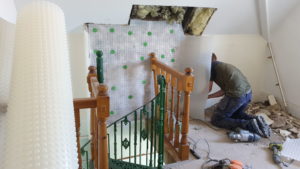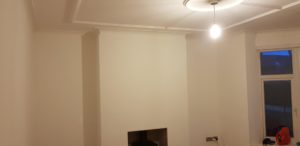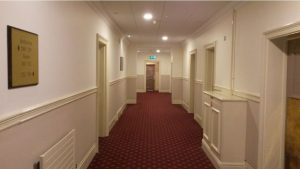
Damp caused by Condensation
Condensation is caused by poor ventilation in a room or building. You may have a room which is very hot in summer and very cold in winter due to the lack of ventilation. You may have a room which has large items of furniture pushed up against walls, allowing no air to circulate behind them. This lack of ventilation causes condensation, which in turn causes black mould.
Many people think that black mould is caused by penetrating damp or rising damp but in most cases It is due to condensation.
Black mould is quite simple to deal with. You can buy a product to clean the mould off the walls. This is simple to use. You apply it to the mould, leave it on for a hour or so to soak in, and then wipe it off. It may not remove all marks; however, it will have cleaned enough for you to paint over with a anti condensation additive.
There are two choices for your paint. There is a product called anti-condensation paint additive, which you add to your normal emultion paint before applying it to the walls.
Or you can use Thermal Paint, which insulates the walls and ceilings when applied. When this paint is dry there will be a noticeable difference to the temperature in the room.
Once the room is free of the mould, it is important to ensure the lack of ventilation is remedied. This can be done by adding an air vent/brick to the room so that air will circulate appropriately preventing any damp from returning.
Rising Damp
Rising damp can be hard to identify. It can look a bit like damp caused by condensation but rather than creating a black mould it looks more like a water stain with flaking paint and bubbles in the plaster (small, white, flaky bubbles caused by salts within the walls).
Rising damp is caused by a build-up of water behind the wall. This water affects the plaster, the mortar, and the stone or brick. It makes these materials expand and can push the plaster off the wall.
It will usually occur at ground level. Most properties have a damp proof course (DPC) installed. However, if the ground outside is higher than the DPC, and you have stains on the walls up to 1m high then that’s a sure sign of rising damp. Rising damp can spread, and so adjoining walls can be affected. It can also travel under the concrete internal flooring and ris up on internal walls.
To cure rising damp, you need to take off at least 1m of plaster from the bottom of the internal wall (can be up to 2 meters in severe cases) and treat the wall with a salt neutraliser. Once this is dry, you then brush the wall down to remove all the salts. A specialised cream is then injected into the wall as low as possible on the inside and 150mm from ground level on the outside. The injections should be made at roughly 100 mm gaps along the length of the wall.
In extreme cases a channel may need to be installed at ground level on the inside and/or outside of the building to allow the wall to be injected at the correct level and allow any water to soak away. This will be particularly important if the outside ground level is above the internal floor level.
Depending on the extent of the problem, there is also an option to add a membrane to the foundations of the building externally, but this is only done in the worst case scenario.
Internally, a cavity wall membrane can be added to allow the wall to breathe, air to circulate and the wall to dry out. The cavity wall membrane can then be boarded over and skimmed so that a new wall surface is created in the room.
Penetrating Damp
Penetrating damp is often caused by things like a leaking gutter, the chimney stack, cracks in brickwork, led flashing not sitting correctly, or windows and doors not fitting correctly. However, the main culprit is usually either the roof or chimney, as they’re exposed to all elements and don’t usually receive regular maintenance.
In cases of penetrating damp, it is vital to do thorough checks of all these things to establish the cause(s).
Penetrating damp looks like a stain, with some salts showing and blown plaster. It is likely to appear high on ground floor walls; anywhere, floor to ceiling, on first floor walls; and in loft spaces. It will often show on chimney breasts. If ceilings are affected, then this is an indication that the issue is with the roof or guttering. Many people incorrectly identify penetrating damp; however, a specialist will know exactly what to look for.
There are several ways to treat this condition, depending on the source. If it is coming from gutters, drainpipes, led flashing, windows, a wire drilled through the house wall, or similar, you need to sort that problem first. The same applies to issues with your roof or chimney – the cause must be sorted first. Often, if it is a chimney, repointing it will be the correct course of action. However, we can also remove the chimney completely if it is no longer in use.
On the inside of the property, if the damp is extreme and untreatable with products like the specialist paints mentioned above, it may be better to just strip the wall right back, install a cavity wall membrane on the whole wall and re-plaster. Trying a number of different treatments could simply be a waste of time and money as none of them will work. A specialist will be able to advise you the best course of action.
If you have any concerns about damp in your property, then please feel free to call us for advice. We not only provide a full remedy service, but also sell all the products mentioned in this blog at our shop in Hillsborough, Sheffield.
Thanks
Jason Fletcher
Company director @ Fletchers Renovations Limited



